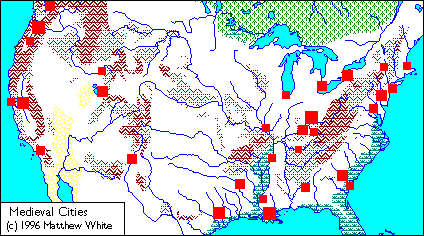
If you'll notice, the eight biggest cities tend to have another smaller city reasonably close by. It was then I noticed on the Eastern map there quite a few locations where cities will be less than one hundred miles of the next one, until the pattern eventually dies out. Usually that restriction is set apart by natural barriers like mountains, but that's not always the case.
I decided to take a look at the larger maps and see which areas had at least three cities (in excess of 25,000) that were no more than 100 miles at a time. Actually, something that occurred to me was that cars were no longer a factor in this world, so driving miles wouldn't count. However, straight distance wouldn't quite tell the tale either. I basically averaged between the two to get an idea. For the most part, I didn't get any real conflict. An odd quirk though, is Grand Rapid, Michigan, which is a considerable land distance from both Chicago and Milwaukee, but much shorter when making most of the trip by water.
Perhaps the biggest chain is the found where it's found today--the Northeast Atlantic Seaboard, containing nine or so cities that so cities that are never more than 100 miles apart. Starting around Boston, it ends around either Washington DC, or depending on how you look at it, Richmond. (That is, if you count Providence and New Haven by straight distance. It would still be seven cities in the chain) The top four shortest distances between cities are found here, and even removing Providence/Boston, (the closest distance between two capitols/District Headquarters) you still find it in the top three. Of course, it's largely stretched out, as the route is some 400 miles long, but never far from the coast, with only the Delaware River cities being inland. As a result, there's definitely room for a wide racial and cultural spectrum between Boston and Washington. However, the trade network of the U.S. Mariners and close proximity of District Supervisors probably helps keep a continuity.
Next is the Mississippi basin, contains seven cities in the chain. It starts at New Orleans, and ends in Shreveport, which are both in present day Louisiana, but curiously, it requires Mississippi-based to keep the under-one hundred-streak going. The is actually rather impressive, considering how much of the area is not conductive to producing larger population densities. This is likely the result of the importance of New Orleans as a trading port and naval power, and it might be no coincidence the lower Mississippi was the base for some of the most advanced Pre-Columbian civilizations. The plurality of these cities are in Red River territory, and note that New Orleans largely practices Voodoo, so this may be the most mixed-faith culture cluster on the continent.
After that we have the Ohio River Valley, which has only four cities that are within a 100 mile chain, but two of them are some of the largest on the continent. These cities are found in present day Ohio and Kentucky, which today make up a single kingdom. There are three other cities in Ohio's borders, one Terre Haute, which is probably a frontier/defense town, (Like medieval York) and Toledo, who's closest city is rather close Detroit. These border cities may or may not feel a shared cultural heritage as the Ohio Valley triangle.
As for the rest of the Eastern U.S., the biggest cluster is around Lakes Ontario and Eerie, with three cities--Buffalo, Toronto, and Rochester. Buffalo is the only major city, but the area is rather special for being cross-coastal, and also containing a piece of Canada. The waterways probably keep it very tight, but the very cold winters keep it from becoming too large.
Then we head to the Western half the country. Its population is much smaller, and much more spread out, as there's less arable farmland, and most of this was filled in by a more modern, automobile-based world. Still, there are some smaller concentrations.
There's California, with the three cities of Sacramento, San Francisco and Stockton. It's something of a mirror of Ohio, with a very concentrated triangle as none of the three cities are more than a hundred miles from each three cities. Fresno manages to be a bit outside that range, although it's mostly accessible by river. Bakersfield and and especially Los Angles are much farther apart.
Finally, we come to the Northwest cluster, or rather clusters, as Porland and Tacoma are pretty far away from each other, and separated by mountains. The "Oregon" half has bigger cities, but the Washington part has more, including two Canadian cities, Victoria, and Vancouver, basically showing how in the new world order of Medieval America, former arbitrary borders don't matter.
